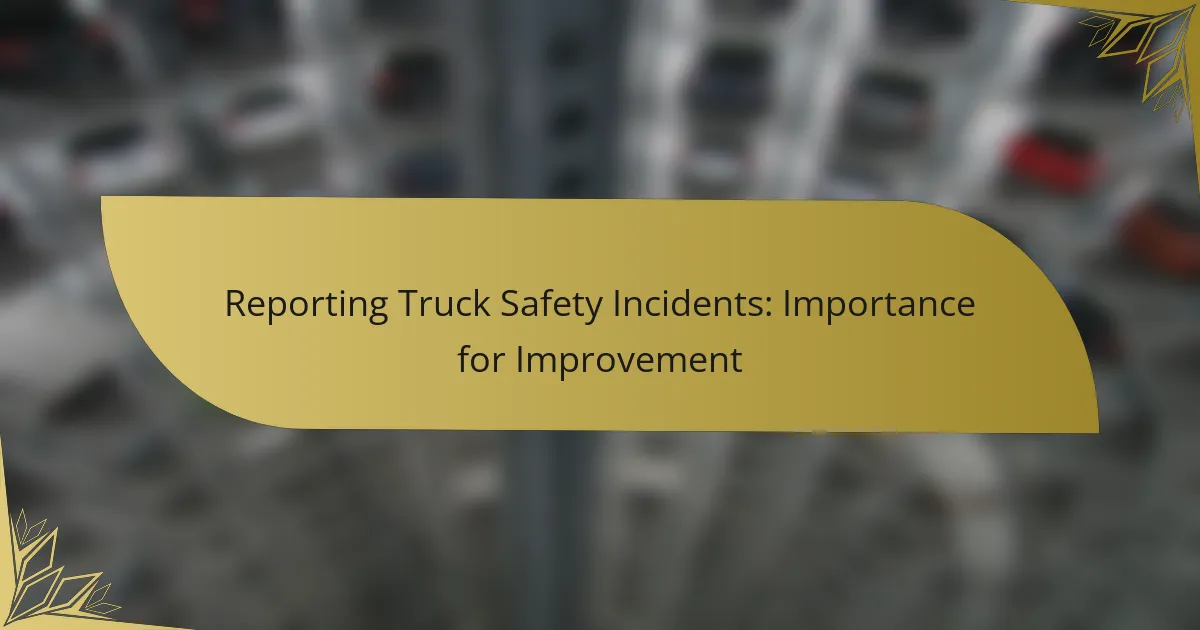Effective reporting of truck safety incidents is essential for improving safety standards and preventing future accidents. By accurately documenting and analyzing these incidents, stakeholders can identify critical areas for enhancement and develop strategies to mitigate risks, ultimately fostering a safer environment within the trucking industry.

What are the best practices for reporting truck safety incidents?
Effective reporting of truck safety incidents is crucial for enhancing safety protocols and preventing future occurrences. Implementing best practices ensures that all incidents are documented accurately and addressed promptly.
Standardized reporting forms
Using standardized reporting forms simplifies the process of documenting truck safety incidents. These forms should include essential information such as the date, time, location, and nature of the incident, as well as details about the vehicles and individuals involved.
Standardization helps in maintaining consistency across reports, making it easier to analyze data for trends and areas needing improvement. Organizations can create templates that align with local regulations and industry standards.
Immediate notification protocols
Establishing immediate notification protocols ensures that relevant parties are informed as soon as a safety incident occurs. This can include notifying supervisors, safety officers, or law enforcement, depending on the severity of the incident.
Timely notifications can lead to quicker responses, which may mitigate further risks or damages. Clear guidelines should be provided to drivers on who to contact and how to report incidents effectively.
Regular training for drivers
Regular training for drivers is essential to ensure they understand the importance of reporting safety incidents and how to do so correctly. Training sessions should cover the procedures for reporting, the use of forms, and the significance of timely communication.
Incorporating real-life scenarios into training can help drivers recognize potential hazards and understand the reporting process better. Ongoing education can keep safety protocols fresh in their minds and encourage a culture of safety.
Use of technology for real-time reporting
Leveraging technology for real-time reporting can significantly enhance the efficiency of incident documentation. Mobile applications and GPS tracking systems allow drivers to report incidents immediately, capturing critical information on the spot.
These tools can streamline the reporting process and reduce the chances of human error. Organizations should invest in user-friendly technology that integrates seamlessly with their existing safety management systems.
Collaboration with safety agencies
Collaborating with safety agencies can provide valuable insights and resources for improving reporting practices. Establishing partnerships with local safety organizations can facilitate knowledge sharing and access to best practices in incident reporting.
Engaging with these agencies can also help in understanding regulatory requirements and ensuring compliance. Regular meetings and workshops can foster a proactive approach to safety and incident reporting within the trucking industry.

How does reporting improve truck safety?
Reporting truck safety incidents is crucial for enhancing overall safety within the industry. By documenting and analyzing these incidents, stakeholders can identify areas for improvement and implement effective strategies to mitigate risks.
Identifies trends and patterns
Reporting incidents helps to uncover trends and patterns related to truck safety. For example, if multiple reports indicate that accidents frequently occur at specific intersections or during certain weather conditions, this information can guide targeted interventions.
Tracking these trends over time allows companies to adjust training programs and operational protocols, ultimately leading to a safer driving environment. Regular analysis of reported incidents can reveal underlying issues that may not be immediately apparent.
Enhances accountability
When truck safety incidents are reported, it fosters a culture of accountability among drivers and companies. Knowing that incidents will be documented encourages drivers to adhere to safety protocols and regulations more diligently.
Accountability can be reinforced through regular reviews of incident reports, which can lead to performance evaluations and necessary disciplinary actions. This transparency helps to create a safer workplace and promotes responsible behavior on the road.
Facilitates regulatory compliance
Reporting safety incidents is often a requirement for compliance with local and national regulations. By maintaining accurate records, companies can demonstrate adherence to safety standards set by authorities, such as the Federal Motor Carrier Safety Administration (FMCSA) in the United States.
Failure to report incidents can result in penalties or increased scrutiny from regulators, making it essential for companies to prioritize accurate reporting. Compliance not only avoids legal issues but also enhances the company’s reputation in the industry.
Promotes proactive safety measures
Regular reporting of truck safety incidents allows companies to adopt proactive safety measures. By analyzing incident data, organizations can identify potential hazards and implement preventive strategies before accidents occur.
For instance, if reports show a spike in tire blowouts, a company might increase tire maintenance checks or invest in higher-quality tires. This proactive approach not only reduces the likelihood of accidents but also lowers costs associated with vehicle repairs and insurance claims.

What are the legal requirements for reporting truck incidents in the USA?
In the USA, truck incidents must be reported according to both federal and state regulations. These requirements ensure accountability and safety improvements in the trucking industry.
Federal Motor Carrier Safety Administration regulations
The Federal Motor Carrier Safety Administration (FMCSA) mandates that certain types of truck incidents, such as accidents resulting in injury or death, must be reported. Carriers must submit a report to the FMCSA within 10 days of the incident, detailing the circumstances and outcomes.
Additionally, if a crash involves hazardous materials, stricter reporting protocols apply. Carriers must ensure compliance with these federal regulations to avoid penalties and enhance safety measures.
State-specific reporting laws
Each state has its own laws regarding the reporting of truck incidents, which can vary significantly. For example, some states require immediate reporting to local authorities, while others may allow a longer timeframe. It’s crucial for trucking companies to familiarize themselves with the specific laws in the states where they operate.
Failure to comply with state-specific regulations can lead to fines and legal repercussions, making it essential to stay informed about local requirements.
Documentation and record-keeping requirements
Proper documentation is vital for reporting truck incidents. Companies must maintain detailed records of all incidents, including accident reports, witness statements, and any correspondence with authorities. This documentation not only aids in compliance but also supports safety audits and insurance claims.
Trucking companies should implement a systematic approach to record-keeping, ensuring that all relevant information is easily accessible. Regular audits of these records can help identify trends and areas for improvement in safety practices.

What tools can assist in truck safety incident reporting?
Several tools can enhance truck safety incident reporting, making the process more efficient and accurate. Key technologies include fleet management software, mobile reporting applications, and dashcam technology, each offering unique features to streamline reporting and improve safety outcomes.
Fleet management software
Fleet management software centralizes data related to vehicle operations, including safety incidents. These platforms often include features for tracking driver behavior, vehicle maintenance, and incident reporting, allowing managers to analyze trends and make informed decisions.
When selecting fleet management software, consider options that integrate with existing systems and offer real-time reporting capabilities. Look for user-friendly interfaces and ensure the software complies with local regulations, which can vary by region.
Mobile reporting applications
Mobile reporting applications enable drivers to report safety incidents directly from their smartphones. These apps often include forms for documenting accidents, uploading photos, and providing GPS coordinates, which can expedite the reporting process.
Choose applications that offer offline functionality, allowing reports to be submitted even without internet access. Ensure the app is intuitive and provides clear instructions to minimize errors during reporting.
Dashcam technology
Dashcam technology records video footage of driving conditions and incidents, providing crucial evidence in case of accidents. Many modern dashcams come with features like collision detection and automatic uploading of footage to cloud storage, enhancing incident reporting accuracy.
When implementing dashcam systems, consider models that offer high-definition video and wide-angle lenses for better visibility. Ensure compliance with privacy regulations, as some jurisdictions have specific rules regarding video recording in commercial vehicles.

What role do insurance companies play in truck safety reporting?
Insurance companies are crucial in truck safety reporting as they analyze incidents to assess risk and determine claims. Their insights help identify patterns that can lead to improved safety measures and reduced accidents.
Claims processing and incident analysis
Insurance companies streamline claims processing by gathering data on truck safety incidents. They analyze this information to understand the circumstances surrounding accidents, which can reveal trends in driver behavior or vehicle performance.
This analysis often includes reviewing driver logs, maintenance records, and accident reports. By identifying common factors in incidents, insurers can provide valuable feedback to trucking companies to enhance safety protocols.
Risk assessment and mitigation strategies
Through detailed incident analysis, insurance companies conduct risk assessments that help trucking firms understand their exposure to accidents. They evaluate various risk factors, such as driver experience, vehicle condition, and route safety.
Based on these assessments, insurers can recommend mitigation strategies, such as enhanced training programs for drivers or improved vehicle maintenance schedules. Implementing these strategies can significantly lower the likelihood of future incidents.
Incentives for safe driving practices
Insurance companies often provide incentives for trucking companies that demonstrate safe driving practices. These incentives can include lower premiums or discounts for companies that maintain a clean safety record or implement advanced safety technologies.
By encouraging safe driving through financial benefits, insurers motivate companies to prioritize safety, ultimately leading to fewer accidents and improved overall safety in the trucking industry.

How can companies foster a culture of safety in trucking?
Companies can foster a culture of safety in trucking by prioritizing safety training, encouraging open communication, and implementing regular safety audits. This proactive approach not only minimizes risks but also enhances overall operational efficiency.
Implementing Comprehensive Training Programs
Comprehensive training programs are essential for instilling a safety-first mindset among truck drivers. These programs should cover defensive driving techniques, vehicle maintenance, and emergency response protocols. Regular refresher courses can help keep safety top of mind.
Consider incorporating hands-on training sessions and simulations to reinforce learning. For example, using driving simulators can provide valuable experience without the risks associated with real-world driving.
Encouraging Open Communication
Encouraging open communication within the trucking company is vital for identifying safety concerns and fostering a culture of accountability. Drivers should feel comfortable reporting incidents or near-misses without fear of repercussions.
Establishing regular safety meetings can facilitate discussions about safety practices and allow employees to share their experiences. This collaborative approach can lead to improved safety protocols and a stronger commitment to safety across the organization.
Conducting Regular Safety Audits
Regular safety audits help companies assess their safety practices and identify areas for improvement. These audits should evaluate compliance with industry regulations, vehicle condition, and driver behavior.
Audits can be conducted internally or by third-party organizations. Companies should aim for quarterly assessments to ensure ongoing compliance and to adapt to any changes in regulations or operational practices.
